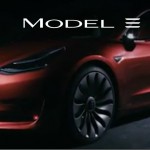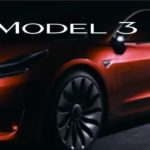News
Tesla granted extension to use “Model 3” in commercial setting by U.S. Patent & Trademark Office

With Ford’s “Model E” still firmly rooted in its trademark rights, it seems Tesla Motors has had to make some important intellectual property decisions as it prepares itself for Model 3 branding ahead of what will be sold to the public. Namely, it looks like they’ve given up the E-based “3” design in favor of the standard character mark “Model 3”.
Teslarati’s legal rep. uncovered records at the U.S. Patent & Trademark Office (USPTO) showing that Tesla originally filed for the E-styled design mark on March 31, 2016, which was then granted allowance on October 4, 2016. In order to fully register the mark, allowing the ® symbol to be used, Tesla must submit a statement and proof of the use of the mark in commerce within six months of allowance – April 4, 2017.
There are many ways to prove that Tesla is using the mark commercially, but the Model 3 page on Tesla’s website has recently stopped using the design on the upcoming vehicle in favor of the standard characters “Model 3”. This likely means that Tesla will abandon the use of the E-based design on the vehicle in favor of the number 3.
Tesla also holds the rights for the “Model 3” mark. It received its USPTO allowance on July 14, 2015 and has since filed three extensions to submit a statement and proof of commercial use. The current extension was made on January 13, 2017 and will expire in July of this year. The timing of the extension filing and the website change could be a signal that the final event for “Model 3” will take place around the 1-year anniversary for last year’s March 31 debut.
One can also stretch and speculate that Tesla may showcase a ride-sharing concept using the Model 3 in a “commercial” setting in its anticipated upcoming event.


Using the “Model 3” mark on anything being commercially produced under the category filed (i.e., “Automobiles and structural parts therefor”) will satisfy the USPTO requirements and give Tesla full rights to the mark. Does this explain the sudden branding change? Tesla may only extend the deadline one more year before it will be considered abandoned. The E-stylized mark, however, still has another two years’ worth of extensions to use.
Tesla’s initial branding goal for the vehicle was to use “Model E” to complete a tongue-in-cheek S-E-X, when combining the names of its “Model S” and “Model X” vehicle. Unfortunately, Ford Motor Company was already using a “Model E” mark, and filed its mark in December of 2013 to secure its full trademark rights. Tesla had actually filed its mark first (August 2013), but the law becomes complicated if someone else is using the mark even without a formal registration.
According to CEO Elon Musk during a 2014 shareholders meeting, Ford threatened to sue Tesla if they pursued their mark, and they abandoned it in April 2014. The E-styled mark was a way around this hiccup in order to maintain the “SEX” combination.
We’ve included a copy of USPTO acceptance of Tesla’s filed extension for use of “Model 3″.
[pdf-embedder url=”http://www.teslarati.com/wp-content/uploads/2017/01/86301895.pdf”]

Elon Musk
Elon Musk and Tesla AI Director share insights after empty driver seat Robotaxi rides
The executives’ unoccupied tests hint at the rapid progress of Tesla’s unsupervised Robotaxi efforts.

Tesla CEO Elon Musk and AI Director Ashok Elluswamy celebrated Christmas Eve by sharing personal experiences with Robotaxi vehicles that had no safety monitor or occupant in the driver’s seat. Musk described the system’s “perfect driving” around Austin, while Elluswamy posted video from the back seat, calling it “an amazing experience.”
The executives’ unoccupied tests hint at the rapid progress of Tesla’s unsupervised Robotaxi efforts.
Elon and Ashok’s firsthand Robotaxi insights
Prior to Musk and the Tesla AI Director’s posts, sightings of unmanned Teslas navigating public roads were widely shared on social media. One such vehicle was spotted in Austin, Texas, which Elon Musk acknowleged by stating that “Testing is underway with no occupants in the car.”
Based on his Christmas Eve post, Musk seemed to have tested an unmanned Tesla himself. “A Tesla with no safety monitor in the car and me sitting in the passenger seat took me all around Austin on Sunday with perfect driving,” Musk wrote in his post.
Elluswamy responded with a 2-minute video showing himself in the rear of an unmanned Tesla. The video featured the vehicle’s empty front seats, as well as its smooth handling through real-world traffic. He captioned his video with the words, “It’s an amazing experience!”
Towards Unsupervised operations
During an xAI Hackathon earlier this month, Elon Musk mentioned that Tesla owed be removing Safety Monitors from its Robotaxis in Austin in just three weeks. “Unsupervised is pretty much solved at this point. So there will be Tesla Robotaxis operating in Austin with no one in them. Not even anyone in the passenger seat in about three weeks,” he said. Musk echoed similar estimates at the 2025 Annual Shareholder Meeting and the Q3 2025 earnings call.
Considering the insights that were posted Musk and Elluswamy, it does appear that Tesla is working hard towards operating its Robotaxis with no safety monitors. This is quite impressive considering that the service was launched just earlier this year.
Elon Musk
Starlink passes 9 million active customers just weeks after hitting 8 million
The milestone highlights the accelerating growth of Starlink, which has now been adding over 20,000 new users per day.

SpaceX’s Starlink satellite internet service has continued its rapid global expansion, surpassing 9 million active customers just weeks after crossing the 8 million mark.
The milestone highlights the accelerating growth of Starlink, which has now been adding over 20,000 new users per day.
9 million customers
In a post on X, SpaceX stated that Starlink now serves over 9 million active users across 155 countries, territories, and markets. The company reached 8 million customers in early November, meaning it added roughly 1 million subscribers in under seven weeks, or about 21,275 new users on average per day.
“Starlink is connecting more than 9M active customers with high-speed internet across 155 countries, territories, and many other markets,” Starlink wrote in a post on its official X account. SpaceX President Gwynne Shotwell also celebrated the milestone on X. “A huge thank you to all of our customers and congrats to the Starlink team for such an incredible product,” she wrote.
That growth rate reflects both rising demand for broadband in underserved regions and Starlink’s expanding satellite constellation, which now includes more than 9,000 low-Earth-orbit satellites designed to deliver high-speed, low-latency internet worldwide.
Starlink’s momentum
Starlink’s momentum has been building up. SpaceX reported 4.6 million Starlink customers in December 2024, followed by 7 million by August 2025, and 8 million customers in November. Independent data also suggests Starlink usage is rising sharply, with Cloudflare reporting that global web traffic from Starlink users more than doubled in 2025, as noted in an Insider report.
Starlink’s momentum is increasingly tied to SpaceX’s broader financial outlook. Elon Musk has said the satellite network is “by far” the company’s largest revenue driver, and reports suggest SpaceX may be positioning itself for an initial public offering as soon as next year, with valuations estimated as high as $1.5 trillion. Musk has also suggested in the past that Starlink could have its own IPO in the future.
News
NVIDIA Director of Robotics: Tesla FSD v14 is the first AI to pass the “Physical Turing Test”
After testing FSD v14, Fan stated that his experience with FSD felt magical at first, but it soon started to feel like a routine.

NVIDIA Director of Robotics Jim Fan has praised Tesla’s Full Self-Driving (Supervised) v14 as the first AI to pass what he described as a “Physical Turing Test.”
After testing FSD v14, Fan stated that his experience with FSD felt magical at first, but it soon started to feel like a routine. And just like smartphones today, removing it now would “actively hurt.”
Jim Fan’s hands-on FSD v14 impressions
Fan, a leading researcher in embodied AI who is currently solving Physical AI at NVIDIA and spearheading the company’s Project GR00T initiative, noted that he actually was late to the Tesla game. He was, however, one of the first to try out FSD v14.
“I was very late to own a Tesla but among the earliest to try out FSD v14. It’s perhaps the first time I experience an AI that passes the Physical Turing Test: after a long day at work, you press a button, lay back, and couldn’t tell if a neural net or a human drove you home,” Fan wrote in a post on X.
Fan added: “Despite knowing exactly how robot learning works, I still find it magical watching the steering wheel turn by itself. First it feels surreal, next it becomes routine. Then, like the smartphone, taking it away actively hurts. This is how humanity gets rewired and glued to god-like technologies.”
The Physical Turing Test
The original Turing Test was conceived by Alan Turing in 1950, and it was aimed at determining if a machine could exhibit behavior that is equivalent to or indistinguishable from a human. By focusing on text-based conversations, the original Turing Test set a high bar for natural language processing and machine learning.
This test has been passed by today’s large language models. However, the capability to converse in a humanlike manner is a completely different challenge from performing real-world problem-solving or physical interactions. Thus, Fan introduced the Physical Turing Test, which challenges AI systems to demonstrate intelligence through physical actions.
Based on Fan’s comments, Tesla has demonstrated these intelligent physical actions with FSD v14. Elon Musk agreed with the NVIDIA executive, stating in a post on X that with FSD v14, “you can sense the sentience maturing.” Musk also praised Tesla AI, calling it the best “real-world AI” today.










